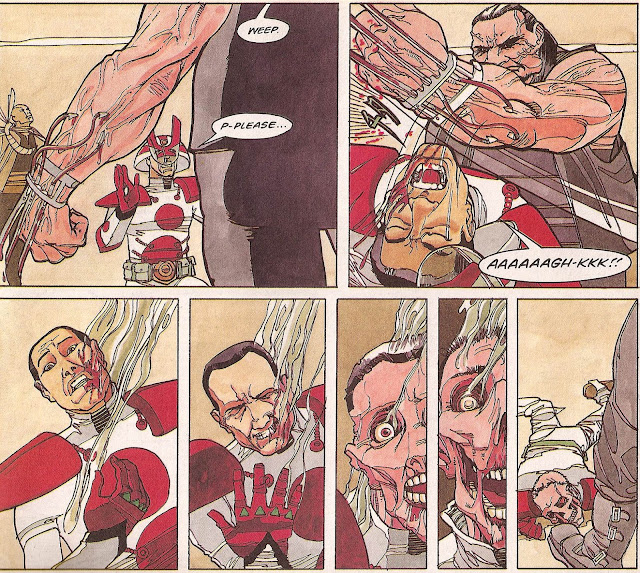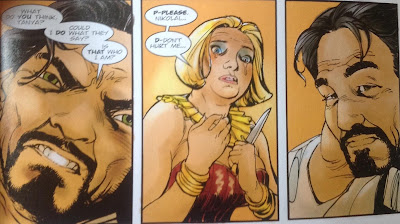First Prog: (as strip artist) 362; (as cover artist) 414
Latest Prog: (as
strip artist) 1727; (as cover artist) 1944
First Meg: (as
strip artist) 213; (as cover artist) 2.52
Latest Meg: (as
strip artist) 334 (as cover artist) 343
Total appearances: 204
-including a total of 65
credits for interior art
-but, for the sake of the
numbers, let’s acknowledge a whopping 144 covers drawn across the Progs, Megs,
specials, reprints (and I’m not even counting his awesome audio dramas and
novels…)
Creator credits:
Mother Earth
Other art credits:
Judge Dredd
Anderson, Psi Division
Venus Bluegenes (in the Rogue
Trooper Action Special, which I’ve never read)
Plenty of Future Shocks and
other one-offs
Notable character creations:
Mother Earth, I guess?
 |
| Mother Earth cares about the planet Words by Bernie Jaye |
Chief Judge Silver
Pretty sure he
designed and drew the first ever Simp, too. You know, the people from Mega City
1 who dress like weird future clowns and sort of predicted the rise of reality
TV stars – you know, people who actively wish to be ridiculous for the sake of
a little fame, while pretending they are merely being true to their inner
selves.
Notable characteristics:
Clean lines; iconic
poses; wonderful imagination; sauciness; cheek bones; creases in clothing; hideous bodily
afflictions.
 |
| For lovingly-rendered yet hideous, flesh-rotting skin, call Cliff Robinson Words by Robbie Morrison |
 |
| 1980s body horror was the best. |
 |
| From sickening diseases to saucy ladies. Dig the Carry-on faces from the two male judges Words by John Wagner |
On Cliff:
For an artist
generally thought of, I think, as a covers man, it’s interesting to note that Cliff
Robinson started out doing interior strips – specifically, Future Shocks – just like everyone else. It simply turned out,
relatively early on, that he has a real knack for an iconic single image,
especially if it involves Judge Dredd. But, in fact, for the first few years of
his long association with 2000 AD, he was as regular on the inside as he was on
the outside.*
 |
| A lovingly vivid death Words by Wagner & Grant |
After those first few Future Shocks, he became part of the
rotating pool of Dredd artists, along with a stint on Anderson, Psi Division as she took on the Dark Judges. Now, I don’t think I’m
being too controversial here, but I imagine Robinson got that gig partly
because he’s something of an adherent of the Brian Bolland school of drawing.
He likes it clean and shiny. By coincidence (or perhaps not), he’s also not the
fastest artist in the world. Like Bolland before him, he probably always had a Dredd episode on the go, but with a gap
between publication and, increasingly, put onto stories that absolutely played
to his strengths.
And then, of course,
there are the covers. With the amount of care that goes into each line lovingly
drawn onto the tiniest crease of fabric, you can forgive Robinson for taking
his time. Over the years, the number of covers he put out crept up into double
figures, while his interior strip work went down to just the odd Dredd or one-off tale here and there
(with one notable exception). Let’s indulge in a little Cliff Robinson cover
appreciation gallery, shall we?
 |
| Love love love those curvy kneee pads and shoulder pads. For my money, Robinsons's biggest contribution the the look of Dredd |
 |
| Hold on, this isn't a cover - it's one of Robinson's many delightful star scans. |
 |
| Robinson tackles 2000 AD's biggest characters |
 |
| Another star scan, lovely touch of humour / sci-fi in-jokery |
 |
| I had this on a mug for a while, once |
 |
| And old school cover for a more modern Prog |
 |
| The sort of cover where you just have to know what's going on inside |
 |
| Tackling the obvious head-on |
 |
| Robinson enters a phase of 'how busy can I make this cover' in style |
 |
| Moving away from Dredd towards more cerebral stuff |
 |
| A new angle on Dredd |
 |
| How many homages to the old days can you spot? |
 |
| Bringing an old Bolland tale to life for a reprint cover |
 |
| Button Man never looked more exciting |
 |
| Last week's prog! He's still got it. |
If he's slowed down a bit in recent years, it may be because he;s being kept super busy by fans who commission work from him! I've no idea what they cost but I get the impression Robinson is very obliging. Splendid.
One interesting curio
about Robinson is that he’s worked well as both a penciller and an inker. It’s
to that common in 2000 AD, but American comics nearly always divide art jobs
this way. I think the idea is that pencillers have to have a good imagination,
and above all a good way with storytelling – basically, they choose how to show
the characters/setting in any given panel, then draw them in with more or less
details. Inkers, on the other hand, have to be good at tracing tone,
atmosphere, and on a more technical level, they have to be good at applying a
line of wet ink onto a clean page of art that can at times be molecule-thin,
and keep it neat. It’s f’in hard, that is.
The point is, Robinson
can do both. He’s worked as an inker over imaginative storytellers such as Mike
Collins, and more recently as a penciller under the blanket of inking workhorse
Dylan Teague.
Now let’s talk about Mother Earth. Sad to say, it’s one of my
all-time least favourite 2000 AD series, but it’s the only series that featured
Robinson as co-creator and full-time artist on. It ran in the late 800s, and
was perhaps the last in an annoyingly long line of new series that seemed
intent on trying to recreate Judge Dredd.** Mother Earth, the character, was
like an eco-Dredd, applying the harshest possible sentencing to people who
committed crimes against the planet. For reasons that make no sense, she
recruits a trio of idiots to help her. I suppose it made a little sense,
because Cliff Robinson had shown on years of Dredd work that he’s excellent at drawing convincing idiots.
 | |
| The piolluters have to drink their own polluted water, see? There's nothing bad about this sequence in itself, but it doesn;t sustain a whole series. Words by Bernie Jaye |
Mother Earth then
proceeds to wreak poetically suitable justice upon corporate polluters and
other scumbags, often with a decent splash of gore (again, playing to
Robinson’s strengths). There’s an argument that the series could have worked.
Pollution is obviously bad; saving the planet obviously good. Stick an OTT
nutter into the mix, and you’ve got a Pat Mills comedy. Sadly the execution
wasn’t funny enough, the idiots didn’t add enough relatability, and Mother
Earth herself, despite being a genuine badass, was simply too powerful for the
concept to make sense. Her goals were clear, but there didn’t seem to be any
obstacle to achieving them, given that she could just teleport in and kill
whoever she wanted, whenever she wanted.
Ending on a high note,
let’s talk about Robinson’s work on Judge Dredd! For a while there, he was picked to produce
some pretty important episodes. He varied between the incredibly silly, but
crucially memorable stuff such as the Booby Prize, which remains my favourite
Dredd vs evil Game Show Host episodes, and then the super in-continuity stuff
like the episode where Chief Judge McGruder takes the long walk and is replaced
by new Chief Judge Silver. On the silly but memorable side – the simps; on the
‘important’ side – the opening episode of Oz,
at the time the first proper Mega-epic in aaaaages.
 |
| This game will kill you. Words by Wagner & Grant |
 |
| I've always thought robinson was especially good at drawing liquids. See also Brian Bolland and Colin Wilson. |
Dredd has three sides:
he’s iconic, he’s outrageous, he’s serious. Robinson brings out the best in all
three.
More on Cliff Robinson
The man's own blog, featuring a vast number of private commissions
 |
| I can't leave without bringing up my favourite Robinson trope: really showing how far forward Dredd's visor would be in front of his face. |
Personal favourites:
Anderson, Psi Division: the Four Dark Judges
Judge Dredd: The Booby Prize; A Chief Judge resigns; Carry on Judging; Simp; Simp
about the House; S.A.M.; Still mental after all these years
Vector 13: Graven images
Pulp Sci-Fi: Eggs is eggs; War of words
Hondo City Justice: Project Behemoth
*It’s all about the
numbers and the counting for me.
**I give you… Dead
Meat feat. Inspector Raam; Trash featuring Trashman Trask; Cannon Fodder;
Calhab Justice feat. Ed MacBrayne;all the roughest, toughest and most noble lawmen in their chosen field.








































